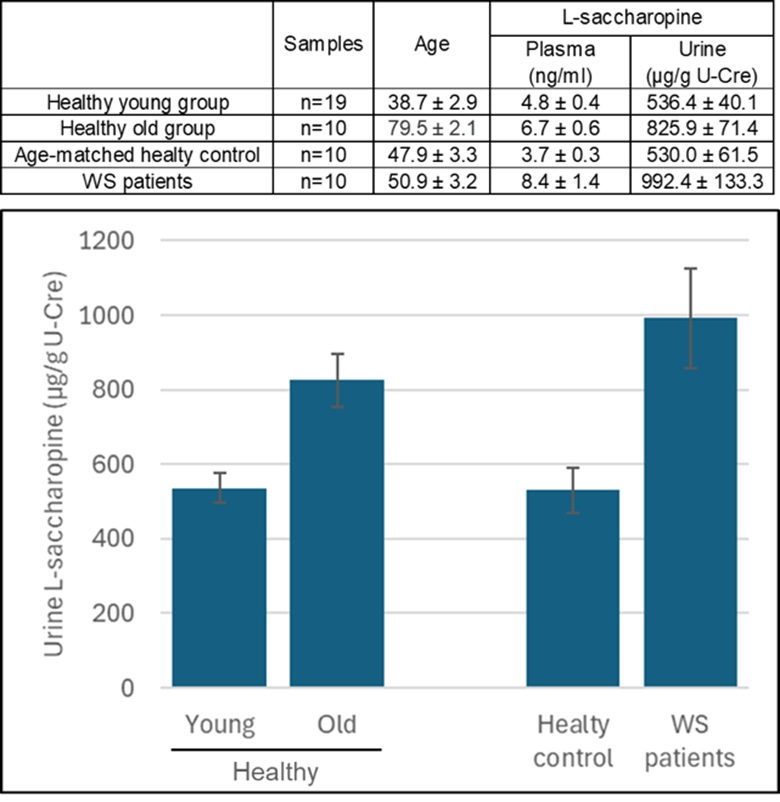Advantage and Core Benefit
- Non-invasive Aging Diagnosis: L-Saccharopine measurement in blood or urine enables a simple and convenient assessment of aging progression.
- Validity as a Biomarker: Strong correlation with progeroid syndromes and mitochondrial dysfunction supports its reliability as an aging biomarker.
- Insight into Anti-Aging Effects: Findings suggest that restricting lysine metabolism has anti-aging effects, potentially leading to the development of anti-aging drugs and functional foods.
Background and Technology
Traditional aging biomarkers include senescence-associated β-galactosidase activity, telomere shortening, and cell cycle inhibitors (p21, p16, etc.). However, these assessments require cell or tissue sampling and analysis, making them invasive. Thus, there is a demand for simpler biomarkers that can be measured using blood or urine samples. L-Saccharopine is an intermediate metabolite in mitochondrial lysine degradation. When it accumulates in mitochondria, it causes a decrease in membrane potential and an increase in reactive oxygen species (ROS), leading to mitochondrial dysfunction and toxicity (DOI: 10.1083/jcb.201807204).
The inventors conducted metabolomic analysis using cells derived from Werner syndrome (WS) patients, a premature aging disease, and discovered that intracellular L-saccharopine levels were significantly elevated in these cells. Further measurement of urinary and plasma L-saccharopine concentrations in both healthy individuals and WS patients revealed that WS patients had significantly higher L-saccharopine levels than healthy controls. Additionally, in healthy individuals, L-saccharopine levels increased with age.
These results indicate that urinary L-saccharopine concentration increases with aging, functioning as both an aging biomarker and a mitochondrial dysfunction-induced aging toxin. Unlike conventional cell- and tissue-based aging assessments, urine samples can be collected non-invasively, making L-saccharopine a practical and user-friendly biomarker for aging assessment.
Data
- L-Saccharopine was quantified using HPLC in urine samples from 29 healthy individuals (ages 22–89) and 10 WS patients (ages 45–66), normalized to urinary creatinine (U-Cre). WS patients had significantly higher urinary L-saccharopine levels than healthy controls. In healthy individuals, urinary L-saccharopine levels tended to increase with age.
- A threshold of 671.9 µg/g U-Cr for identifying individuals aged 70 and older yielded a specificity of 80% and a sensitivity of 84.2%.
- WS patient-derived cells were cultured for four months in lysine-containing and lysine-restricted media. Under lysine restriction, cell proliferation (cPDL) was maintained for two months, and the proportion of senescent cells (assessed via β-galactosidase staining) was significantly reduced.
 |
Patent
WO2022259950
Researcher
Dr. Naoya Kato, Dr. Yasuo Ouchi, Dr. Hiyori Kaneko, Dr. Zenro Maezawa, Dr. Hiroyuki Eto, Dr. Kotaro Yokote (Chiba University, Faculty of Medicine)
Expectations
We seek partnerships with companies interested in drug discovery and anti-aging product development through collaborative research on aging biomarkers and mitochondrial metabolism.
Potential collaboration partners include:
Diagnostic and chemical companies: Developing simple and efficient L-saccharopine measurement methods.
Pharmaceutical companies: Evaluating anti-aging drugs and compounds affecting mitochondrial function using biological samples.
Health food and anti-aging product developers: Assessing product efficacy through urinary L-saccharopine measurements.
Project ID:WL-05160


